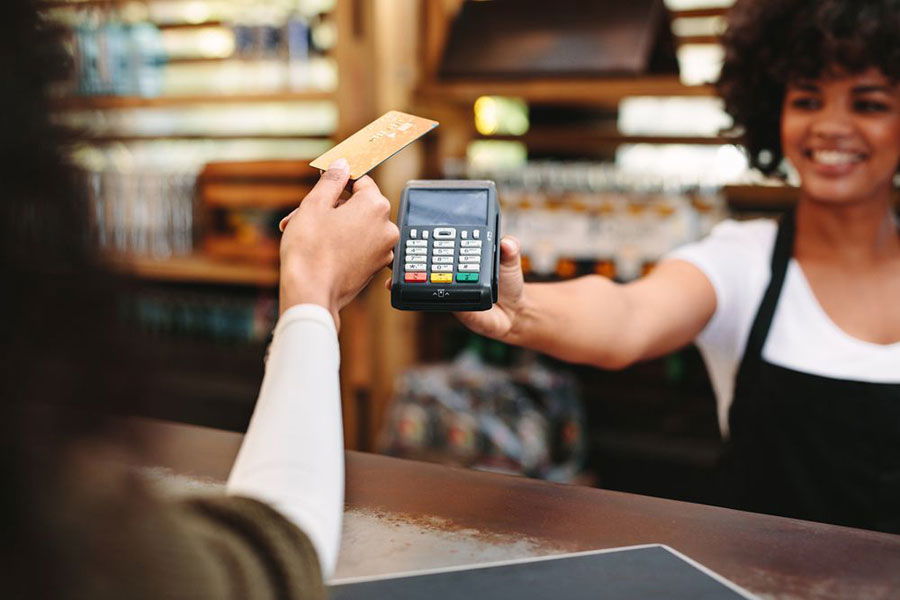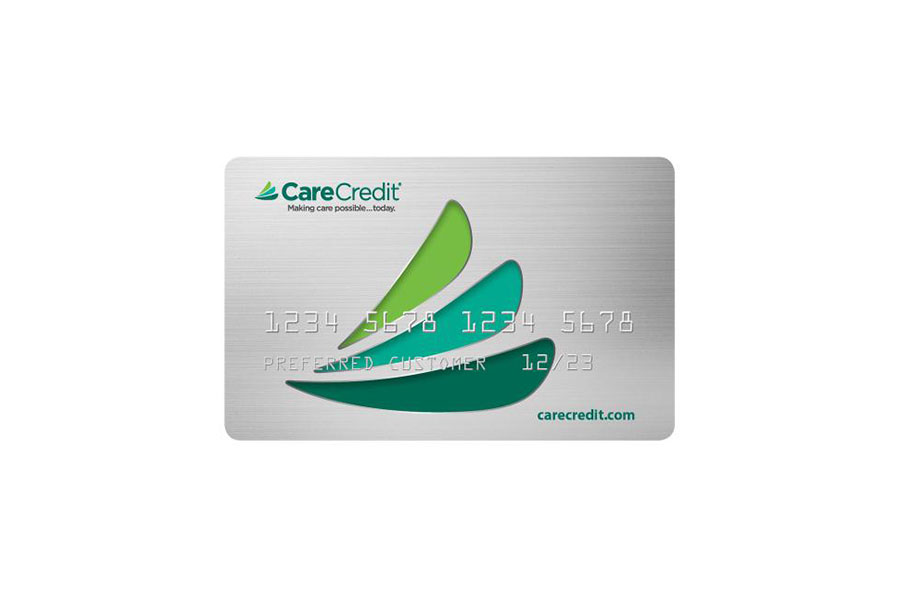Consumers today can make purchases in various ways: Debit cards, credit cards, mobile wallet payments (like Apple Pay and Google Pay), and even cash or paper checks. It’s not surprising if you’re confused about the many payment methods available today.

And the two forms of payment mostly commonly confused? Credit cards and debit cards.
Credit Cards vs. Debit Cards
Debit and credit cards both make it easy to make purchases online and at the point of sale in stores. Today’s EMV (Europay, Mastercard, and Visa) chip technology uses encryption to generate a unique account number that’s only used for a single transaction. These advances make credit and debit cards reasonably secure from certain types of cyber theft.
Credit and debit cards are also safer and more hygienic than cash. Instead of handling money that’s been touched by hundreds of people, you just press a few buttons to complete a sale. New “contactless” cards use Near-field communication (NFC) combined with EMV technology. This allows customers to “tap-and-go” for an even faster, more sanitary sale.
Considering these similarities, we’re here to clear up any confusion about the difference between a debit card and a credit card. By the end of this article, you should know which card would be best for you in specific circumstances.
What is a debit card?
There are two types of debit cards: bank debit cards and prepaid debit cards.
Bank Debit Card
Bank debit cards are issued by banks and credit unions when you open a checking account. This kind of debit card is linked to your checking account.
You can use it to make a purchase or take money out of your checking account at an ATM. Using a debit card can help prevent overspending because you can only spend up to the amount you have in your bank account.
Be sure to use your debit card at ATMs provided by your bank to save a few bucks. Otherwise, you might pay additional out-of-network ATM fees when you withdraw cash.
Prepaid Debit Card
Prepaid debit cards aren’t linked to your bank account. Instead, you load money onto the card and use it for purchases. When the balance gets low, you have the option of adding more money onto the prepaid card. You can purchase prepaid debit cards at retail stores and online.
Overdraft Fees
If you have overdraft checking, transactions might clear if you don’t have the money in the bank to cover the purchase. But your bank may charge additional fees, called overdraft fees.
Some debit cards work a little differently than those tied to your bank account. If you use a prepaid debit card like Bluebird from American Express, you load money onto the card from a bank account or payment service, like PayPal or Venmo. Here is a list of some other top prepaid debit cards.
You can usually use a prepaid debit card anywhere you can use debit or credit cards. Most prepaid debit cards carry monthly fees and some charge per use. However, most bank-issued debit cards linked to checking accounts do not charge fees other than the bank’s checking account fees.
Debit Card Pros and Cons
Pros
Debit cards have many advantages over using cash or checks to make purchases. Along with the benefits of added safety and security, debit cards:
- Withdraw money from your account immediately, so you don’t have to wait for payments to clear
- Help you keep track of your spending through your online banking account
- Usually do not have fees associated with their use (except for prepaid debit cards)
- Are widely accepted at places that take Visa and Mastercard
- Make it easier to control your spending, as you can’t spend money you don’t have in the bank
Cons
As convenient as they are, it’s best not to use a debit card for certain types of transactions. Many car rental companies, for instance, don’t accept debit cards unless you’re willing to leave a large deposit.
If you’re checking into a hotel room, the hotel may put a hold on your card that exceeds the cost of your room. If you’re on vacation, you may not want to have that money tied up, especially since it can take a week or more for those funds to become available again.
Other drawbacks of debit cards include:
- High fees on prepaid debit cards
- Fewer opportunities to earn rewards for your spending
- No perks or benefits
- Using a debit card won’t help you build credit history or increase your credit score
What is a credit card?
A credit card allows you to borrow money from your credit card company to make purchases. You can spend up to the credit limit on your card. If you try to make a credit card purchase, and it would put you over your limit, the purchase may be declined, or you may get hit with over-the-limit fees.
Once the credit card bill arrives, you must pay the minimum amount by the due date. The credit card issuer calculates this minimum payment as a percentage of your credit card balance, including interest charges.
That’s right. Interest charges are one of the major drawbacks to using credit cards. If you don’t pay your balance in full, you might pay interest on the amount you owe.
Promotional Offers
Certain promotional offers provide 0% interest for a limited time—typically 12 to 18 months—or on specific purchases. But if you don’t pay your balance before the introductory period runs out, you’ll have to pay the interest that would have built up over the prior months.
If you aren’t careful with money, it’s easy to overspend with credit cards, thinking you’ll just pay it off later. As the interest adds up, and you still have to pay your regular monthly bills, you can get into trouble over-charging more than you can pay off each month.
Too much credit card debt and high balances on your credit cards can lower your credit score. This makes it harder to get the best rates on loans and negatively affects your life in many other ways, too.
Credit Card Pros and Cons
Pros
Even with all this in mind, using a credit card for purchases has several advantages over debit cards. The best credit cards come with many perks and benefits. Some of these may include:
- Some credit cards let you earn points, miles, or cash back rewards
- Free credit score monitoring
- Identity theft protection
- Extended warranty protection (if you buy an item with a credit card, the bank may double the manufacturer’s warranty)
- Purchase price protection (if you find an item at a lower price within a certain amount of time, your credit card company will refund the difference)
- Cell phone insurance (when you pay your monthly bill using your card that has this benefit)
And let’s talk about the rewards.
Whatever your credit score, you can usually find a credit card with at least a modest rewards program. For every dollar you spend, you’ll receive a percentage (typically 1% to 2%, but sometimes up to 5% or more) in cashback or points you can redeem for merchandise, gift cards, a statement credit, or travel.
If you have a high credit score, you can qualify for top-tier rewards cards. Many people take vacations for free with rewards earned through rewards cards like Chase Sapphire Reserve or the American Express Gold card.
Very few debit cards today offer any kind of rewards. However, they are becoming more common.
Cons
Secure, easy to use, and offering lucrative opportunities to earn rewards, it may seem like credit cards are the hands-down best choice for anyone.
But if you have trouble controlling your spending, it’s not wise to rack up too much available credit by applying for multiple cards. You could be tempted to charge your cards to the limit.
Unless you have a 0% interest offer or pay your bill in full every month, credit card interest can add up quickly.
In addition, credit cards have a few other drawbacks for consumers who don’t use them wisely and pay the balance in full when it comes due.
- Some credit cards have annual fees
- Late fees if you don’t pay your bill on time
- High balances or late payments can lower your credit score
- Risk of overspending until you can’t make the minimum payments
- Your credit card could be declined if you spend over the credit limit
Bottom Line
Debit cards let you conveniently make purchases using money in your checking account. They carry few fees and several advantages, including the ability to track your spending in real-time.
But if you learn how to leverage credit card rewards, you can earn cashback that can help you stretch your budget. If you only charge what you know you can afford and pay your bill in full each month, the right credit cards can unlock a whole new world of perks, benefits, and rewards.
Frequently Asked Questions
What is the main difference between a debit card and a credit card?
The primary difference between a debit card and a credit card lies in how they handle payments. A debit card allows you to spend the money you already have in your bank account, deducting the purchase amount directly from your account balance.
In contrast, a credit card lets you borrow money from the credit card company up to a predetermined credit limit. You must repay the borrowed amount later, and if not paid in full by the due date, you may incur interest charges. Essentially, a debit card uses your existing funds, while a credit card extends a line of credit that you repay over time.
When should I use a credit card instead of a debit card?
Credit cards can be advantageous in certain situations. For example, when booking a hotel room or renting a car, using a credit card is often preferred because hotels and rental agencies may place holds on funds, which can tie up your available balance when using a debit card. Additionally, credit cards may offer added benefits like rental car insurance coverage and extended warranties on purchases, making them a more suitable choice for certain transactions.
Do prepaid debit cards offer the same level of security as bank-issued debit cards?
Prepaid debit cards are generally secure, but the level of security can vary depending on the specific card and issuer. Bank-issued debit cards typically have robust security features and protections against unauthorized transactions. Prepaid cards may offer security features like PIN protection and fraud monitoring, but it’s advisable to review the card’s terms and conditions to understand the security measures in place.
What are some common security practices for protecting both debit and credit cards?
Common security practices include regularly monitoring your account statements for unauthorized transactions, safeguarding your card’s PIN, and reporting lost or stolen cards immediately. For credit cards, it’s crucial to pay attention to credit reports, which can help detect identity theft or unusual account activity. Additionally, using secure and unique PINs or passwords for online and mobile banking can enhance card security.




